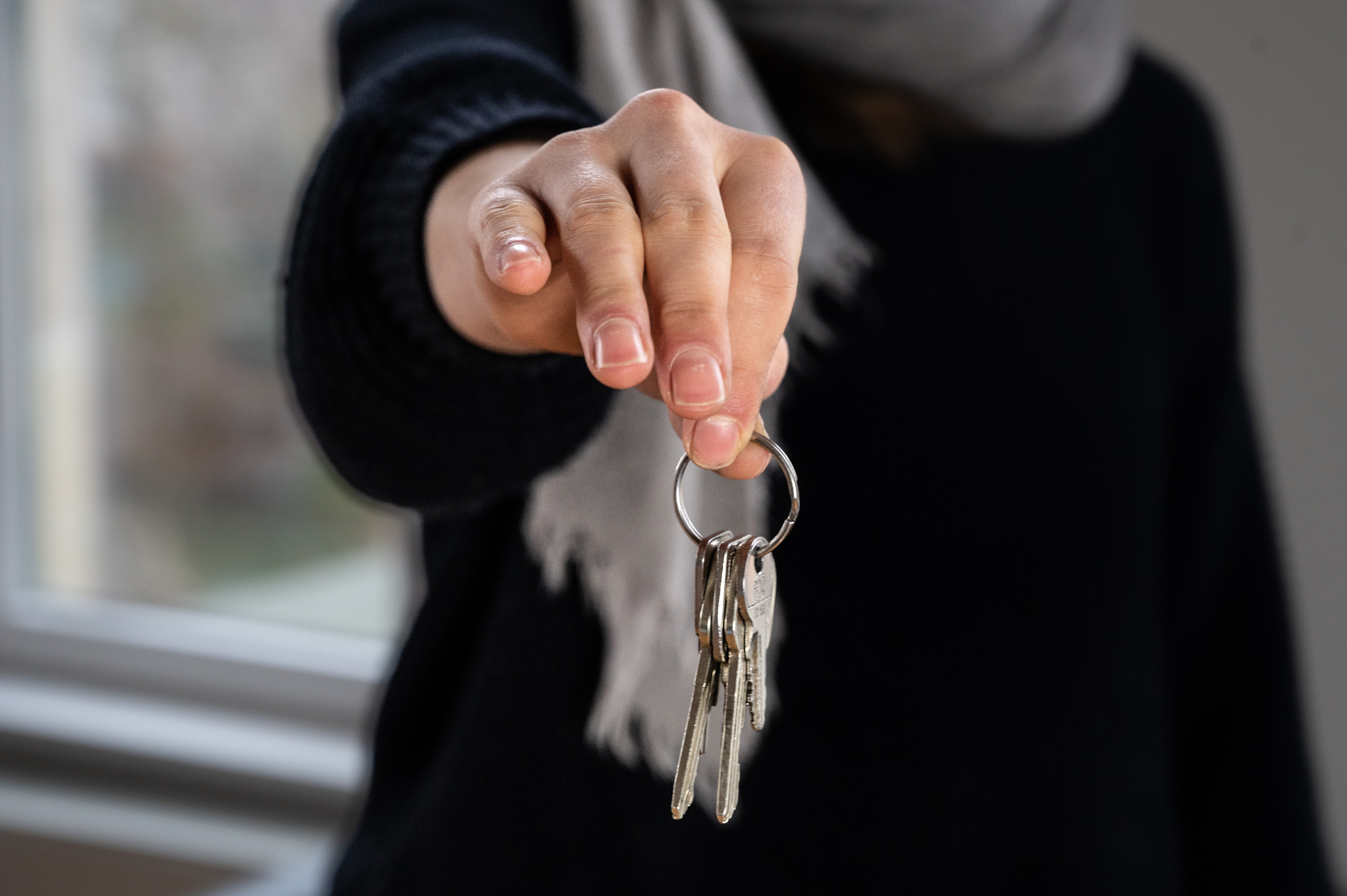The handover certificate and getting your keys: here's how it works
The keys to your investment

The home stretch: preparing a handover certificate and getting your keys
Getting the keys to your newly purchased property is the last big step in the real estate buying process. It's an excellent opportunity to look back on everything you've accomplished and see just how far you've come: You found a great piece of real estate you wanted to buy. You reviewed all of the property documentation in detail. Maybe you even negotiated with the seller to get a better price. You got your financing situated. You signed the purchase agreement and got it notarized. And all of the parties to the agreement have met their contractual obligations. Way to go!
The most crucial part of the last stretch was transferring the agreed price in full to the seller. Sellers are generally advised not to hand the keys over to the buyer until every last cent of the purchase price has been paid.
So now it's time to arrange an appointment to get the keys to your new apartment or (in many cases) house, and this is where the handover protocol comes into play. To minimize any potential friction, the handover certificate should ideally contain a record of everything:
If you can't be at the handover meeting in person, you should try to find someone who can fill in for you, such as an expert who understands how these things are supposed to work.
Once all the required information has been added to the handover certificate and any remaining defects or damages have been fixed, it's time to get the keys. FINALLY!
To learn more about what information is included in your handover certificate and what you need to have before you can get the keys to your new property, keep reading. 👇👇
- Why is it important?
- This must go in
- hand over the keys
- Hand over as landlord
- FAQ
Why the handover certificate is so important when you're buying real estate
The handover certificate might sound like some lame bureaucratic formality, but it's actually an essential document designed to protect you during the handover process so that you don't get stuck footing the bill for damages you didn't cause.
The handover certificate also protects the seller against unjustified compensation claims for damages caused either by you or your tenants after the handover.
Even if you've already visited the property in person before or taken a 360° online tour of it, the handover meeting will probably be the first time you see your purchased house or apartment without any furniture in it. If there's mold on the wall behind a wardrobe, or if the floor under the kitchen unit is completely scuffed up, you'll be able to see it as plain as day. If you do find damage, you're entitled to have it fixed. Each item that needs to be fixed and the date it needs to be repaired goes right into the handover certificate.
You often can't tell if there are hidden damages such as broken pipes or damp walls just by looking around. If you want to check for these, it might be a good idea to hire a professional to help you.
By the way: Damages that you were already aware of go in the handover certificate, too. The seller can also write down the current status of these damages and/or what agreement the two of you have reached.
At worst, if you find out after the handover that there are damages that the seller did not disclose in the handover certificate, you'll at least be entitled to a warranty claim. If you find severe damages, you can even claim compensation or demand rescission of the purchase agreement, but you'll need to be able to provide clear evidence of willful intent on the part of the seller.
The handover certificate isn't just for documenting defects and getting the seller to fix them, though. To ensure that utilities are billed correctly in the future, for example, both parties need to know what the meter readings were on the day of the handover. As such, the readings for heating, electricity, and water need to be included in the handover certificate.
What needs to go in the handover certificate
The handover certificate is one of many important documents in the real estate buying process. Don't just skim over the items. Instead, go through everything very carefully before your handover meeting. Or have a professional do it for you. In most cases, the seller or real estate agent is the one that fills out the certificate. However, that doesn't mean you can't do it instead. We recommend agreeing about this with the other parties beforehand so that you don't have multiple people showing up with pen and paper in hand.
The handover certificate is an official document. For this reason, there are a few formalities that it must include:
The names and addresses of the buyer and seller
Information about the property: address, the exact date of the handover, information about recent renovation work, by what date the ancillary costs and fees were paid
Next, we have defects and damage. We recommend going room by room. At the end of the inspection, you want all parties to understand what needs to be fixed in which rooms. Also, set a deadline for any repairs that need to be done.
Room-by-room overview
An inspection of the outside area, if there is one
Deadline for repairs
As mentioned above, the readings from your utility meters have to be included in the handover certificate as well. The meter numbers and readings for the following utilities are important:
Water
Heating
Electricity
Gas
Oil
The amount and type of fixtures included need to be documented, too. That also goes for the number of keys — house keys, room keys, garage keys, and everything in between.
It's also important to make sure you get all property documents. These include:
Construction drawings
Ground plan
Insurance documents
Maintenance agreements
Energy certificate
Current property tax notice
Invoices for recent renovation work (for potential warranty services)
Current rental agreement
Tenant records
Agreements with service providers
If witnesses attend the meeting, their first and last names, addresses and signatures should also be added to the certificate.
Finally, the certificate needs to be signed by you and the seller.
It adds up quickly. If you need any additional tips or information about the handover certificate or the handover itself, stop by our Community. There are plenty of pros there who've been through all this at least once.
When does the appointment to get my keys actually take place?
Having a checklist is all well and good, but how the heck are you supposed to know when the handover appointment takes place? That's easy: your purchase agreement states that the keys will be handed over to you when the purchase price has been paid. Keys for cash, basically.
There are, of course, exceptions. You might come across arrangements where the keys are handed over before payment. But it's a risky move for the seller: what if your property financing falls through at the last second? Nevertheless, if this is an option for you and the other party, your notary can certainly advise you on what potential securities there are. And since this is considered a consulting service in connection with a purchase agreement, you won't have to pay any additional notary fees.
Switching roles: handover certificates and meetings for landlords
So you've gotten the handover certificate and meeting out of the way. But instead of moving into your new property, you want to rent it out. In your new role as landlord, you now need to prepare a handover certificate for your tenants and hand the keys over to them, assuming you haven't hired a property management company to do all of this for you.
The keys are handed over twice for each tenancy: once at the start of the tenancy and once at the end. A handover certificate and inspection report should be filled out for each handover meeting to document any damages (and whether you will have them repaired before the tenants move in). You'll also have a clear record of how many keys you handed over (and what will happen if they are lost).
Got property management responsibilities coming your way but still don't have a clue what you're supposed to do? Just ask in the Urbyo community.
Proper Documentation – Why Accurate Record-Keeping Is Anything but a Minor Detail
Technical property inspections may seem uneventful at first glance. But anyone who thinks it's just about “taking a quick look and snapping a few photos” is underestimating the reality. Minor defects in existing buildings are common – worn seals, broken door closers, cracked windows, graffiti, or damaged bollards. Nothing dramatic – but a logistical challenge. A small issue can quickly turn into a coordination marathon: janitors, property managers, insurers, contractors, owners, tenants – everyone has a say, and everyone has different priorities.
Without accurate documentation, chaos is inevitable. That’s why a structured, traceable record is the backbone of every inspection. The goal: to legally document the building’s condition at a specific point in time.
What belongs in a solid inspection report?
A reliable report is more than just a few notes and smartphone photos. It must hold up in court. That means including:
Date, time, and duration of the inspection
Participants: Who was on site?
Weather conditions (if relevant)
Defects, documented with:
Photo
Precise location (e.g., "Living room, right side of window front")
Description, including responsibility or cost estimate
Without these elements, a report isn’t worth much—more of a personal impression than a legally valid document.
The most common documentation mistakes
Most mistakes happen due to haste or routine. Here are the biggest offenders:
Missing time information: Without a time stamp, the report can be legally challenged.
Photos without context: A photo without explanation helps no one.
Copy-paste errors: Mismatched descriptions and locations—embarrassing and unprofessional.
Assumptions instead of facts: Unverified observations don't belong in a report.
Too much text, not enough clarity: Focus on quality, not quantity.
Documentation is project management on a small scale
Whether it’s for maintenance, handover, or part of a technical due diligence, property inspections are not a side task. They require clear procedures, structured communication, and precise documentation. When done properly, they save significant time, stress, and costs down the road.
So: Don’t just observe—record. Don’t just write—document with structure. And remember: One documented defect with proof is worth more than ten undocumented ones without a plan.



